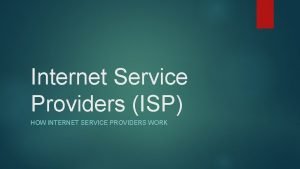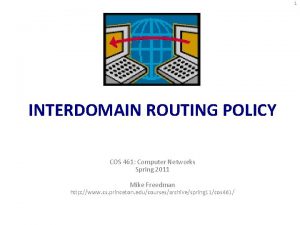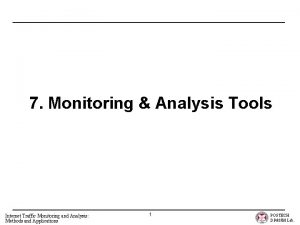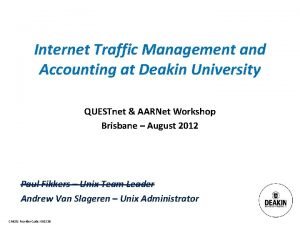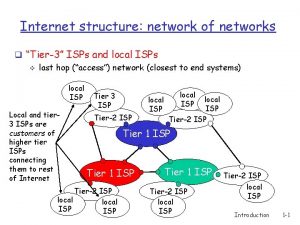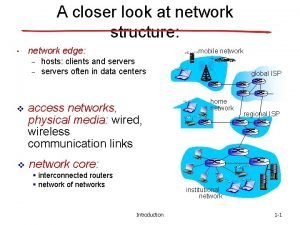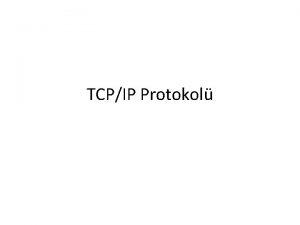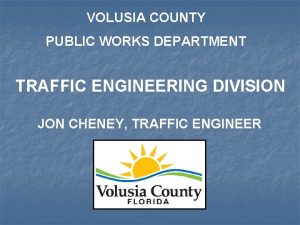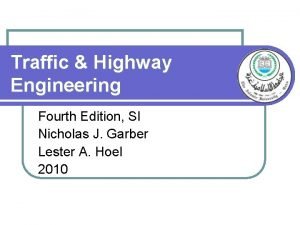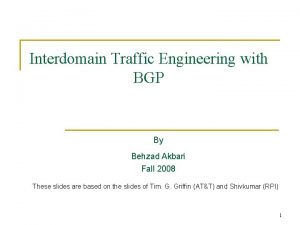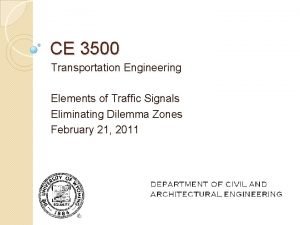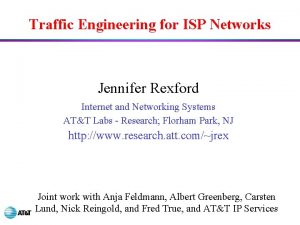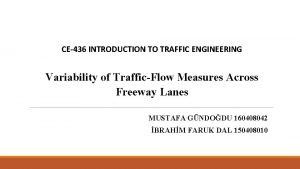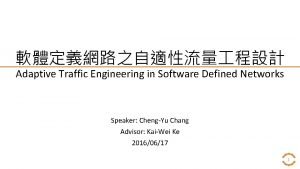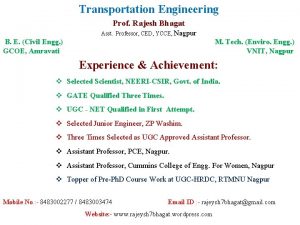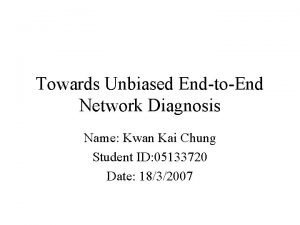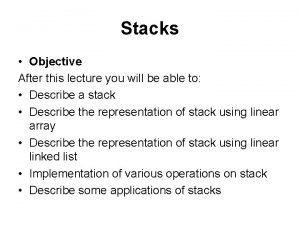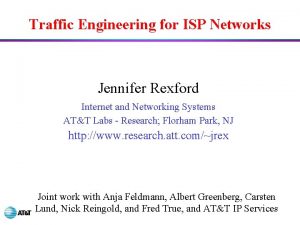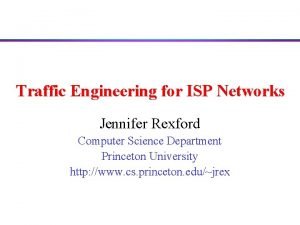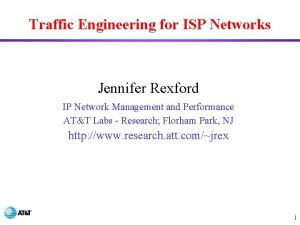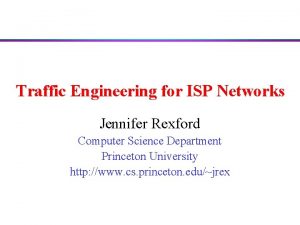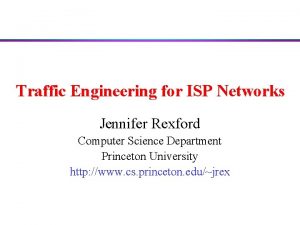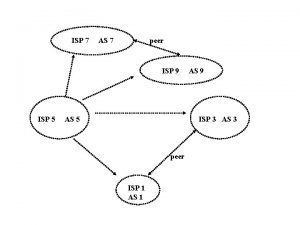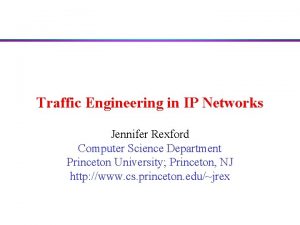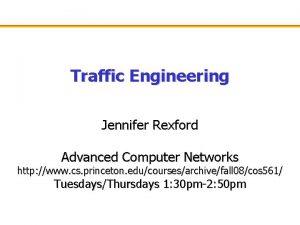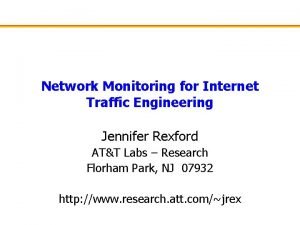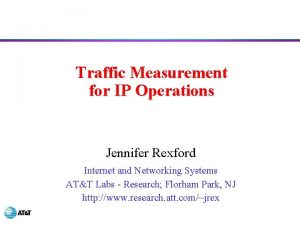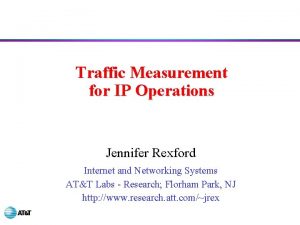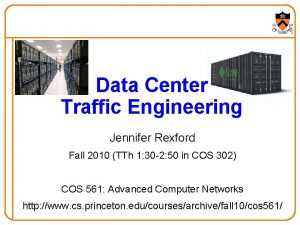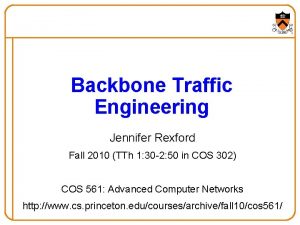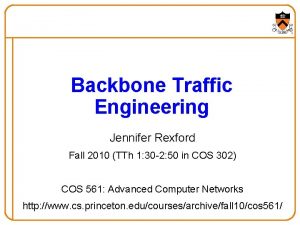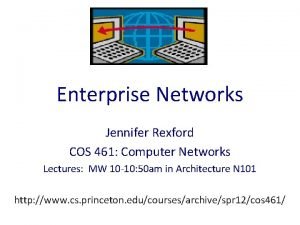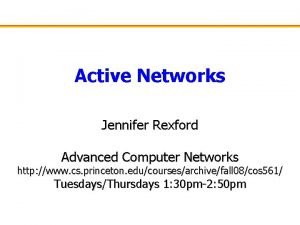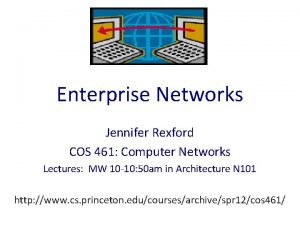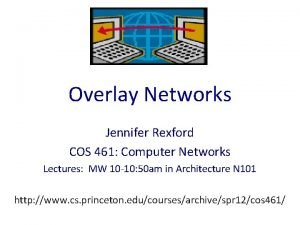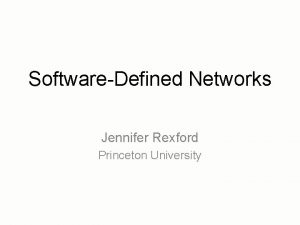Traffic Engineering for ISP Networks Jennifer Rexford Internet































- Slides: 31

Traffic Engineering for ISP Networks Jennifer Rexford Internet and Networking Systems AT&T Labs - Research; Florham Park, NJ http: //www. research. att. com/~jrex

Who am I, and Why am I Here? u Who am I? – Princeton EE class of ‘ 91, Ph. D in ‘ 96 from U. Michigan – AT&T Research from 1996, in the IP Network Measurement and Engineering Department – Joining the Princeton CS faculty in February 2005 u Why am I here? – Working closely with operators of AT&T’s IP network – Creating tools for them to engineer the flow of traffic – Applying optimization techniques to real problems

Outline u Background – Internet architecture – Interdomain and intradomain routing – Internet service provider backbone u Traffic engineering – Optimizing routing to prevailing traffic – Local search to select the integer link weights u Inferring the traffic matrix – Working backwards from link loads u Conclusion and ongoing work

Internet Architecture u Divided into Autonomous Systems – Distinct regions of administrative control – Routers and links managed by an institution – Service provider, company, university, … u Hierarchy of Autonomous Systems – Large, tier-1 provider with nationwide backbone – Medium-sized regional provider with smaller backbone – Small network run by a single company or university u Interaction between Autonomous Systems – Internal topology is not shared between ASes – … but, neighboring ASes interact to coordinate routing

Autonomous Systems (ASes) Path: 6, 5, 4, 3, 2, 1 4 3 5 2 1 7 6 Web server Client

Interdomain Routing: Border Gateway Protocol u ASes exchange info about who they can reach – IP prefix: block of destination IP addresses – AS path: sequence of ASes along the path u Policies configured by the AS’s network operator – Path selection: which of the paths to use? – Path export: which neighbors to tell? “I can reach 12. 34. 158. 0/24 via AS 1” “I can reach 12. 34. 158. 0/24” 2 1 data traffic 12. 34. 158. 5 3 data traffic

Internet Service Provider Backbone neighboring providers modem banks, business customers, web/e-mail servers How should traffic be routed through the ISP backbone?

Interior Gateway Protocol (Within an AS) u Routers flood information to learn the topology – Routers determine “next hop” to reach other routers… – By computing shortest paths based on the link weights u Link weights configured by the network operator 2 3 2 1 1 1 3 5 4 3

Heuristics for Setting the Link Weights u Proportional to physical distance – Cross-country links have higher weights than local ones – Minimizes end-to-end propagation delay u Inversely proportional to link capacity – Smaller weights for higher-bandwidth links – Attracts more traffic to links with more capacity u Tuned based on the offered traffic – Network-wide optimization of weights based on traffic – Directly minimizes key metrics like max link utilization

Why Are the Link Weights Static? u Strawman alternative: load-sensitive routing – Link metrics based on traffic load – Flood dynamic metrics as they change – Adapt automatically to changes in offered load u Reasons why this is typically not done – Delay-based routing unsuccessful in the early days – Oscillation as routers adapt to out-of-date information – Most Internet transfers are very short-lived u Research and standards work continues… – … but operators have to do what they can today

Our Approach: Measure, Model, and Control Network-wide “what if” model Offered Topology/ traffic Configuration measure Changes to the network control Operational network

Traffic Engineering in an ISP Backbone u Topology – Connectivity and capacity of routers and links u Traffic matrix – Offered load between points in the network u Link weights – Configurable parameters for Interior Gateway Protocol u Performance objective – Balanced load, low latency, service level agreements … u Question: Given the topology and traffic matrix in an IP network, which link weights should be used?

Key Ingredients of Our Approach u Instrumentation – Topology: monitoring of the routing protocols – Traffic matrix: widely deployed traffic measurement u Network-wide models – Representations of topology and traffic – “What-if” models of shortest-path routing u Network optimization – Efficient algorithms to find good configurations – Operational experience to identify key constraints

Formalizing the Optimization Problem u Input: graph G(R, L) – R is the set of routers – L is the set of unidirectional links – cl is the capacity of link l u Input: traffic matrix – Mi, j is traffic load from router i to j u Output: setting of the link weights – wl is weight on unidirectional link l – Pi, j, l is fraction of traffic from i to j traversing link l

Multiple Shortest Path With Even Splitting 0. 25 0. 5 1. 0 0. 25 0. 5 Values of Pi, j, l

Defining the Objective Function u Computing the link utilization – Link load: ul = Si, j Mi, j Pi, j, l – Utilization: ul/cl u Objective functions – minl(ul/cl) f(x) – minl(S f(ul/cl)) x 1

Complexity of the Optimization Problem u NP-complete optimization problem – No efficient algorithm to find the link weights – Even for the simple convex objective functions u Why can’t we just do multi-commodity flow? – E. g. , solve the multi-commodity flow problem… – … and the link weights pop out as the dual – Because IP routers cannot split arbitrarily over ties u What are the implications? – Have to resort to searching through weight settings

Optimization Based on Local Search u Start with an initial setting of the link weights – E. g. , same integer weight on every link – E. g. , weights inversely proportional to link capacity – E. g. , existing weights in the operational network u Compute the objective function – Compute the all-pairs shortest paths to get Pi, j, l – Apply the traffic matrix Mi, j to get link loads ul – Evaluate the objective function from the ul/cl u Generate a new setting of the link weights repeat

Making the Search Efficient u Avoid repeating the same weight setting – Keep track of past values of the weight setting – … or keep a small signature (e. g. , a hash) of past values – Do not evaluate a weight setting if signatures match u Avoid computing the shortest paths from scratch – Explore weight settings that changes just one weight – Apply fast incremental shortest-path algorithms u Limit the number of unique values of link weights – Do not explore all 216 possible values for each weight u Stop early, before exploring the whole search space

Incorporating Operational Realities u Minimize number of changes to the network – Changing just 1 or 2 link weights is often enough u Tolerate failure of network equipment – Weights settings usually remain good after failure – … or can be fixed by changing one or two weights u Limit dependence on measurement accuracy – Good weights remain good, despite random noise u Limit frequency of changes to the weights – Joint optimization for day and night traffic matrices

Application to AT&T’s Backbone Network u Performance of the optimized weights – Search finds a good solution within a few minutes – Much better than link capacity or physical distance – Competitive with multi-commodity flow solution u How AT&T changes the link weights – Maintenance done every night from midnight to 6 am – Predict effects of removing link(s) from the network – Reoptimize the link weights to avoid congestion – Configure new weights before disabling equipment

Example from My Visit to Our Operations Center u Amtrak repairing/moving part of the train track – Need to move some of the fiber optic cables – Or, heightened risk of the cables being cut – Amtrak notifies us of the time the work will be done u AT&T engineers model the effects – Determine which IP links go over the affected fiber – Pretend the network no longer has these links – Evaluate the new shortest paths and traffic flow – Identify whether link loads will be too high

Example Continued u If load will be too high – Reoptimize the weights on the remaining links – Schedule the time for the new weights to be configured – Roll back to the old weight setting after Amtrak is done u Same process applied to other cases – Assessing the network’s risk to possible failures – Planning for maintenance of existing equipment – Adapting the link weights to installation of new links – Adapting the link weights in response to traffic shifts

Conclusion of This Part of the Talk u IP networks do not adapt on their own – Routers compute shortest paths based on static weights u Service providers need to adapt the weights – Due to failures, congestion, or planned maintenance u Leads to an interesting optimization problems – Optimize link weights based on topology and traffic u Optimization problem in NP-complete – Forces the use of efficient local-search techniques u Results of the local search are useful – Near-optimal solutions that minimize disruptions

Computing the Traffic Matrix Mi, j u Hard to measure the traffic matrix – IP networks transmit data as individual packets – Routers do not keep traffic statistics, except link utilization on (say) a five-minute time scale u Need to infer the traffic matrix Mi, j from – Current topology G(R, L) – Current routing Pi, j, l – Current link load ul – Link capacity cl

Inference: Network Tomography From link counts to the traffic matrix Sources 5 Mbps 3 Mbps 4 Mbps Destinations

Tomography: Formalizing the Problem u Ingress-egress pairs – p is a ingress-egress pair of nodes (i, j) – xp is the (unknown) traffic volume for this pair Mi, j u Routing – Plp is proportion of p’s traffic that traverses l u Links in the network – l is a unidirectional edge – ul is the observed traffic volume on this link u Relationship: u = Px (work backwards to get x)

Tomography: One Observation Not Enough u Linear system of n nodes is underdetermined – Number of links e is around O(n) – Number of ingress-egress pairs c is O(n 2) – Dimension of solution sub-space at least c - e u Multiple observations are needed – k independent observations (over time) – Stochastic model with Poisson iid counts – Maximum likelihood estimation to infer matrix u Doesn’t work all that well in practice…

Approach Used at AT&T: Tomo-gravity u Gravitational assumption – Ingress point a has traffic via – Egress point b has traffic veb – Pair (a, b) has traffic proportional to via * veb 9 6 3 20 10

Approach Used at AT&T: Tomo-gravity u Problem with gravity model – Gravity model ignores the load on the inside links – Gravity assumption isn’t always 100% correct – Resulting traffic matrix might not satisfy the link loads u Combining the two techniques – Gravity: find a traffic matrix using the gravity model – Tomography: find the family of traffic matrices consistent with all link load statistics – Tomo-gravity: find the tomography solution that is closest to the output of the gravity model u Works extremely well (and fast) in practice

Conclusions u Managing IP networks is challenging – Routers don’t adapt on their own to congestion – Routers don’t reveal much information about traffic u Measurement provides a network-wide view – Topology – Traffic matrix u Optimization enables the network to adapt – Inferring the traffic matrix from the link loads – Optimizing the link weights based on the traffic matrix
 Assembly language instruction
Assembly language instruction Local isp vs regional isp
Local isp vs regional isp Gao rexford conditions
Gao rexford conditions Inbound traffic vs outbound traffic
Inbound traffic vs outbound traffic All traffic solutions traffic cloud
All traffic solutions traffic cloud Traffic management in computer networks
Traffic management in computer networks Datagram switching and virtual circuit switching
Datagram switching and virtual circuit switching Basestore iptv
Basestore iptv Internet traffic analysis tools
Internet traffic analysis tools Internet traffic management
Internet traffic management Internet transport protocol in computer networks
Internet transport protocol in computer networks Tier 3 isp
Tier 3 isp Internet structure network of networks
Internet structure network of networks Computer networks and internets with internet applications
Computer networks and internets with internet applications The internet is a combination of networks glued together by
The internet is a combination of networks glued together by Osi vs tcp/ip
Osi vs tcp/ip Volusia county traffic engineering
Volusia county traffic engineering Traffic and highway engineering 4th edition
Traffic and highway engineering 4th edition Multi leg intersection
Multi leg intersection Traffic engineering bgp
Traffic engineering bgp Average delay in traffic engineering
Average delay in traffic engineering Elements of traffic engineering
Elements of traffic engineering Traffic engineering studies
Traffic engineering studies Traffic engineering studies
Traffic engineering studies Traffic engineering
Traffic engineering Introduction to traffic engineering
Introduction to traffic engineering Highway engineering syllabus
Highway engineering syllabus Traffic engineering network
Traffic engineering network Transportation engineering
Transportation engineering What is internet
What is internet Who isp
Who isp Isp icp postfix
Isp icp postfix

